To Assess and Celebrate
How was the Life Celebration day?
Were there still any doubts about this activity?
Which other suggestions can be made to this activity?
Based on what was seen and sensed, what else would you like to share?
Do you remember any message, reflection or prayer that celebrates this moment?
“There are many different forms of activity, but in everybody it is the same God Who is at work in them all. The particular manifestation of the Spirit granted to each one is to be used for the general good.” 1Co 12: 6-7
To See
The child from one year to one year and eleven months old
1. What do the children of your community like to do in this age?
2. What in your view is a good way to react to the child’s stubbornness?
The child from one year to one year and five months old
How the child can learn and grow
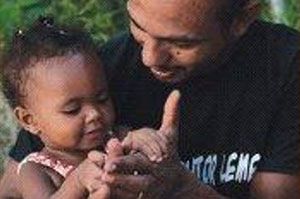
Foto:
Do the family members speak and talk to the child?
The child is every time more interested in getting to know everything that he/she sees: objects, plants, animals. He/she likes that people show and speak to him/her about the things that he/she sees and catches. He/she is also interested in pictures or photos in magazines and books. Saying the name of what the child is looking at, encouraging to repeat it and talk to him/her about the daily activities, help the child learning to speak.
The child already can speak some words such as: mother, water, and ball. But he/she still makes use of gestures to communicate: gives kisses, swings the head to say “no”. To learn how to speak the child needs that people speak to her. He/She likes when the family speak to her asking for help. For example: “Take daddy’s shoes under the bed”. Acting like this the child starts to have the knowledge about places: below, above, close to, far from.
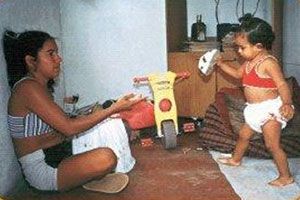
Foto:
Does the child understand when people ask him/her something?
The child can understand some orders such as: “Let us go out.”, “Take your shoes”. It is not always that the child replies to the orders she is given. Generally the child only obeys when she/he is interested in doing what he/she is asked to do.
The child shows what he/she wants and what he/she does not want to do. When he/she does not want to do something, sometimes the child gets stubborn. Keep on saying “no”, scare the child or beat her/him, does not avoid the stubbornness. Leader, instruct the parents that the best thing to do is to wait till the stubbornness is over, not to give much attention to the child while he/she is stubborn and be firm regarding the prohibition made. When the child realizes he/she does not manage what he/she wants, the child gives up that state and starts doing something else.
When playing with boxes, cans or pots, the child learns to better use the hands. When the child takes out and puts one thing inside the other, the child is also learning the notion of size. The family can take advantage of this interest in taking out and putting in things to teach the child how to put away his/her toys in a bag or box.
The child likes to go in and out of boxes, basins and open cabinets. He/she is learning about sizes, shapes and is increasingly controlling his/her movements.
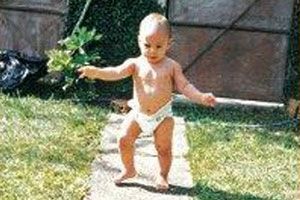
Foto:
The child is learning to walk without the help of another person. This is a great achievement!
Even though the child falls sometimes, he/she will try walking because he/she has the wish to learn and do lots of things. With the family’s help, the child is going to feel safe and walk better each time in the environment around him/her. Since the child can walk around the house and is very curious, he/she grabs everything that he/she manages to catch. If the child falls and gets hurt, it is recommended to make cold or icy bandages to reduce the pain and the swollenness.
Attention: The family needs to watch for the safety of the child, keeping the doors closed, windows protected, holes, wells and water containers covered and medications and cleaning products out of the child’s reach. It is also necessary to watch for the child not to put toxic plants in the mouth because they can poison him/her.
Feeding and breastfeeding
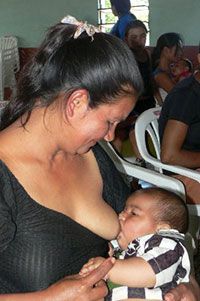
Foto:
Leader, explain to the parents and family members that the child in this age eats the same food that the family does, just in lesser quantity. Since the child has already more teeth, he/she manages to chew better. The child already likes to try to eat and drink holding the spoon and the glass with his/her own small hand. In doing so the child starts to learn to eat on his/her own.
In order to avoid food to be spoiled it is recommended hat the parents put small quantities of the food in he child’s dish. As soon as the child has eaten the food that was put there, the parents put a little more till the child leaves the rest in the dish or refuses more food.
Besides eating other types of food it advisable the child to be breastfed in between the meals. The mother milk continues to be a health source for the child!
Leader, when the child is gaining too much weight, it is good to talk to the parents about the family habits. Children that are breastfed have less chances to be overweight after they are grown ups.
Obesity can cause breathing problems, high pressure and diabetes.
“ …disease comes with a lot of food, and intemperance leads to crumps. Through gluttony many passed away; however, though, who is sober, prolongs his/her life.” Ecc 37, 30-31
Hygiene
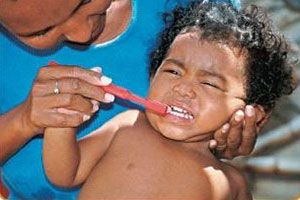
Foto:
The child now has already several teeth and it is necessary to have them all very well cleaned. For doing so, a soft and small toothbrush should be used, without toothpaste. Instruct the parents to:
Brush doing circular movements the external teeth close to the cheek; After that, brush the inner teeth close to the tongue; Do the shuttle movement in the flat part of the back teeth;; Brush also well the gums and the tongue.
It is important to brush the child’s teeth after each meal, after eating sweet food and before going to bed. This avoids the formation of a bacterian plate that causes the tooth decay.
The mouth health depends on healthy food and of the teeth hygiene.
The appearance of a white stain on the teeth is the first sign of alert. This stain means that there is a tooth decay but that that there is no hole there yet. It is then necessary to take the child to the dentist.
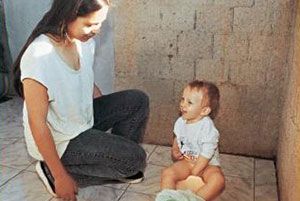
Foto:
The child still cannot control the muscles that hold the wee and the poohs. When the child or someone notices that the child is willing to wee or evacuate, it is recommended to put the child on the chamber pot/jordan and verify if the child does it. Never force the child, because he/she is young and, little by little, she/he is going to understand that there is a proper place to wee or to pooh.
It is necessary to teach the child to wash the hands before the meals, like all the family members do.
Using latrines or toilets avoids that the worms of the faeces contaminate the people and cause diseases. To avoid the appearance of rats, cockroaches and insects that bring diseases, the garbage should be kept in closed plastic bags and not be thrown in the street or in empty unoccupied lands. The cares with hygiene, inside and outside the house, are important for the health of the whole community.
Vaccines

In the 12th month, the child takes:
A dose of the Viral Triple (VTV) against measles, mumps and rubeola.
In the 15th month the child takes: Reinforcement of the vaccine against Poliomyelitis; Reinforcement of the vaccine DTP – the triple vaccine (against tetanus, diphtheria and whoop.
Leader, if a child does not have the vaccines records taken or has lost the Health Card, instruct the family to go to the health service unit. There the professionals can make a new Health Card and give the missing vaccines doses.
Leader, encourage the mothers to take their children to be vaccinated on the Vaccination Campaign days!
The child from one and a half year to one year and eleven months old
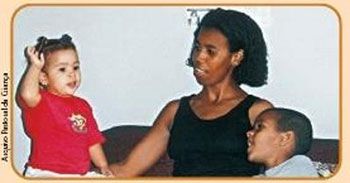
How the child can learn and grow
Does the child communicate using short sentences?
The child now learns easily many new words. If the child has been taught, he/she can show and say the name of the body parts: head, belly button, hand, foot.
If the family talks to the child, he/she can also learn to joint two or three words to make up small sentences: “daddy ball” (daddy, give me the ball), “mummy go out” (mummy let’s go out). It is good that the family members seek to understand what the child wants to say. Thus they are encouraging him/her to learn to speak better.
The child keeps on very interested in learning and using everything that sees around her. The curiosity helps the child to learn better. The child does things that he/she sees people doing: uses the mother’s shoe, puts on the father’s belt.
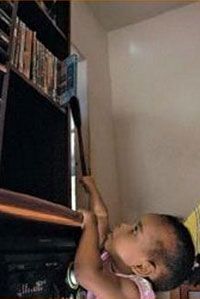
Foto:
The child’s thought is more developed and he/she shows this in the activities he/she does. For example, when he/she wants to catch something he/she does not reach, the child does not wait for someone to catch it for him/her, but uses something else to reach what she /he wants. He/she, for example, takes a piece of wood to pull the ball that is under the bed.
The child learns to say “no”. If the adults leave dangerous things close to him/her, or many things that she cannot touch, they will have to say “do not touch it” and “do not take it” all the time. Since the child imitates the adults, he/she will say “no” to everything people ask him/her for. In order not to say “no” to everything, it is better the parents put many things he/she cannot touch out of his/her reach. Then, the child will learn what he/she can and what he/she cannot touch, but does no longer have to hear “no” to everything.
It is important not to leave dangerous things at the child’s reach and show the child what he/she can play with.Limits are important for the child’s development.

Foto:
The child’s skill with the hands increased. He/she already manages to open lids and make scrawls on a paper or on the floors.
The child likes to play piling up, putting down, mounting and dismounting things. The family can provide him/her with pieces of wood of different sizes and shapes and well sanded, for he/she can play with the wooden pieces in several different ways.
In this age, the child, in general, is interested in knowing about his/her genitalia. He/she does it the same way he/she does to get to know other things: looking at it and touching it. When the child touches these organs, he/she will have good sensations. If the parents do not chide when the child touches the genitalia he/she has the opportunity to get distracted with other plays/toys, and his or her curiosity little by little decreases
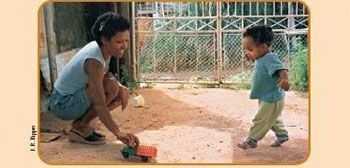
Foto:
The child walks better everyday, starts to run a little and loves to go up on top of everything. He/she crawls up the staircases and goes down them, sitting. If someone holds the child's hand, he/she is able to go up the staircase standing. The child who is helped to do things learns better.
The child likes to walk pulling things tied with a cord or pulling toys. He/she also likes to play imitating animals: walks like a dog, lopes/rides on a piece of wood like riding a horse, etc.
In this phase, the child enjoys more playing with other children, but still can fight for toys. The parents’ patience is very important at these times. Beating does not educate the child and only worsens the situation.
Playing with water, sand and earth quietens the child. He/she spends a long time exploring, learning how they are like and what can be done with these materials. But the places where the child plays have to be clean.
"He has given his angels orders about you to guard you wherever you go." Psa 91:11
Crawler

Foto:
If the child has crawler, instruct the mother to comb the child’s hair with a thin comb everyday, after washing them, and using a medicine prescribed by the doctor. It is also necessary to take care of the child´s towel, bed sheets and if the people who are taking care of the child also have crawler.
To avoid contamination of crawler to be spread, it is necessary to:
Take care of hygiene and take a bath/shower everyday;
Keep the hairs cleaned;
Change clothes everyday;
Not use someone else’s comb;
Prevent the child from wearing hats, caps or woollen bonnets borrowed from someone else.
 The crawler is a parasite that lay eggs (nits) in the hairs.
The crawler is a parasite that lay eggs (nits) in the hairs.
These eggs are white, small and do not get loose easily.
They cause itching.
Attention: It is never recommended to:
Use insecticide to kill the crawler because it can cause serious intoxication to the child;
Put a plastic bag the child’s head because this can cause asphyxia
Mange
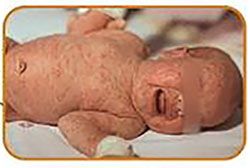
Foto:
Mange appears in the form of small red balls that make up a tunnel underneath the skin. They come up on the whole body, especially between the fingers, in the axilla/armhole, in the waist, in the buttock and in the genitalia, causing a lot of itching.
The contamination occurs by the contact with the skin or objects of people with mange, such as: clothes, towels or bed sheets.
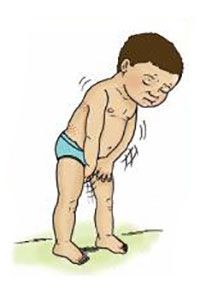
Foto:
It is necessary to take proper medication to heal the mange. During the treatment, the clothes, including the bath towels and bed sheets have to be washed and ironed with very hot iron besides being changed everyday. Leaving these sheets, clothes and towels drying under strong sun also helps.
It is good to clean the children nails in order to take out the parasites that remain there when the children itch their skin and also to avoid contamination. If anybody else in the family has mange, it is necessary that all take the treatment at the same time.
The daily bath/shower with soap and water, washing the hair and wearing clean clothes help to prevent the contamination by crawler, mange and other skin diseases.
Attention: If the child bathes in a bath tub or deep basin, it is necessary that someone stays always nearby to avoid the child to get drowned.
Feeding and Breastfeeding
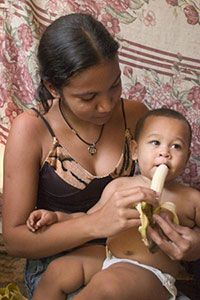
Foto:
The child already knows how to eat on his/her own. When the child eats together with the family, he/she eats better. It is necessary that he/she have a snack in between meals, for his/her stomach is small and cannot take much food. In these snacks it is advisable to offer him/her regional fruit. The child who since early age eats several fruit, vegetables and legumes receives bigger quantities of vitamin, iron and fibres, besides acquiring healthy eating habits.
It is recommended that in the first years of age the child is prevented from eating food with sugar, coffee, canned food, fried food, soft drinks, candies, caramels, salty snacks and other cakes, biscuits etc. They are not healthy and they take the appetite for the child to eat nutritious food.
Evaluation and Feedback Meeting
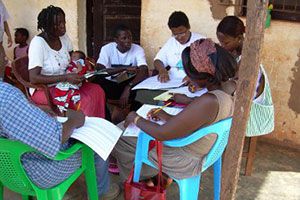
Foto:
Leader, the Evaluation and Feedback Meeting is a very important activity of your work. In these meetings, apart from celebrating the achievements obtained, it is possible to discuss the difficulties that are being encountered in your daily work. Many of these difficulties can be solved with actions that you can take after a good talk among yourselves.
In this meeting, which shall be held on the first 10 days of every month, you can study the situation of the families who you follow, discuss each month results and encourage each other with the solutions found.
The same study and reflection method used in this Guide helps to organize and stimulate the Evaluation and Feedback Meeting. Thus, the meeting begins with the evaluation of the actions of the previous month and the celebration of the achievements. After that, we See, by the results of the FABS, the reality experienced by the followed families; Evaluating, that is, think about the reality of these families in the light of the Bible, of the Leader’s Guide and of other materials available and, then, plan the Actions together with the families.
We now shall see in details about this method of Seeing, Evaluating, Acting, Assessing and Celebrating.
Organizing an Evaluation and Feedback Meeting
the beginning of the meeting it is important that you, leaders, warmly welcome each other and that you have a moment of prayer to strengthen your friendship, union and faith.
To See
After the welcome moment, you should See and Evaluate the previous month.
The questions below may help with that:
a) Which actions proposed in the last meeting were accomplished?
b) Which were the achievements obtained?
c) Which problems came up?
d) How are the children and the pregnant women of your community?
In order to help to answer these questions it is important to fill in the FABS sheet. To facilitate this, it is good that each leader comes to the meeting with the fourth part of her/his book already filled in.
After having filled in the FABS sheet, you can talk about the families who you follow, answering the following questions:
a) According to the FABS result, what other problems appear in your community?
b) Which followed families are going through more difficulties?
You can choose the situation of a followed child or of a pregnant woman that needs more attention at the moment. The leader that follows this family can give more details about the difficulties that she/he faces. It is important that the other leaders ask questions to better understand the situation.
To Evaluate
For the Evaluation moment it is important to read the Leader’s Guide regarding the pregnant woman or the child, depending on the case chosen to be detailed. If the group is iscussing, for example, the case of a pregnant woman who is in the 5th pregnancy month, then about this phase it should be read in the Leader’s Guide, trying to verify the problems that pregnant woman is facing and to identify their causes. If the group chose, for example, the case of a one year-old child, they should read about this age in the Leaders’ Guide, verifying which of the health care and development opportunities the child has. In this study session it is also important to have the Bible and the Ten Commandments of Peace in the Family at hand, since they can bring the necessary light to help even more that family. The Child’s Pastoral Journal is also a tool that should be used. You will have information about this Journal on page 268 of this Guide.
For the Acting moment, the group can plan the following points:
a) What actions should be continued by the family?
b) What other actions should be introduced to this or to other families?
c) Who else can help?
d) Life Celebration Day;
e) The next meeting: who is going to receive the people, make the prayers, prepare the place, coordinate the meeting, etc.
f) The celebration of the achievements reached by the families. It can be a community moment in the church services or in other meeting moments in the community.
Many facts can be celebrated such as: the birth of a child, a father of a family that has got a job, the water that had the quality improved the sanitation that arrived in the neighbourhood, the new school, etc.
It is important to give value to the capacity of the families of transforming the difficult situations of life in victories and accomplishments.
To end the meeting, the leaders should evaluate what they have learnt, verify what can be improved for the next meeting; and thank God for that union, for the learning, for the strength and everybody for their friendship.
In the Evaluation and Feedback Meetings, the leaders shall find ways to solve some problems that affect several families; it may be necessary to invite the area coordination and the community entities.
"We must consider how to rouse one another to love and good works. We should not stay away from our assembly, as is the custom of some, but encourage one another, and this all the more as you see the day drawing near." Heb 10: 24-25
Suggestion for Task of this Qualification Stage
Prepare an Evaluation and Feedback Meeting.



